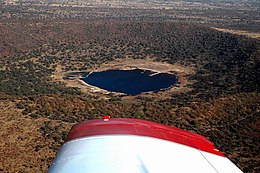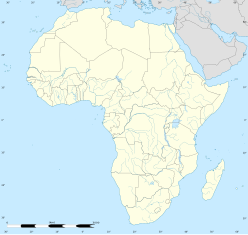| Tswaing crater | |
|---|---|
 Tswaing crater as seen from above | |
| Impact crater/structure | |
| Confidence | Confirmed |
| Diameter | 1.13 km (0.70 mi) |
| Depth | 100 m (330 ft) |
| Impactor diameter | 30 to 50 m (98 to 164 ft) |
| Age | 220 ± 52 Ka |
| Location | |
| Coordinates | 25°24′32″S 28°4′58″E / 25.40889°S 28.08278°E |
| Country | South Africa |

Tswaing (Tswana for "place of salt"[1]) is an impact crater enclosed by a 1,946 ha nature reserve, situated in northern Gauteng province, South Africa. The crater and reserve are situated on a base of ancient granite of the Bushveld Igneous Complex, some 40 km to the north-northwest of Pretoria (just north of Soshanguve).[1] This astrobleme is 1.13 km in diameter[1] and 100 m deep[2] and its age is estimated to be 220,000 ± 52,000 years (Pleistocene).[3] The impactor is believed to have been a chondrite or stony meteorite some 30 to 50 m in diameter that was vaporised during the impact event.[3][4] Morokweng impact structure, another South African crater of chondrite origin, lies north-west of Vryburg. Since 1996 it falls under the auspices of Ditsong Museums of South Africa.[1]
- ^ a b c d Koeberl, Christian (1999). "An impact crater for the people: The Tswaing (Saltpan)crater, South Africa". Meteoritics & Planetary Science. 34 (6). NASA Astrophysics Data System: 827–828. Bibcode:1999M&PS...34..827K. doi:10.1111/j.1945-5100.1999.tb01399.x. Retrieved 4 April 2023.
- ^ Reimold, W.U. (1998-04-27). "Meteorites and Meteorite Craters". South African Astronomical Observatory (SAAO). Retrieved 2008-08-23.
- ^ a b "Tswaing and its environmental effects". Lunar and Planetary Institute. Retrieved 2008-08-23.
- ^ "Tswaing". Earth Impact Database. Planetary and Space Science Centre University of New Brunswick Fredericton. Retrieved 2009-08-16.


